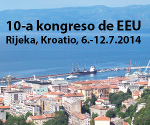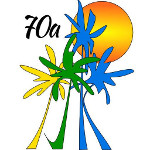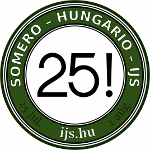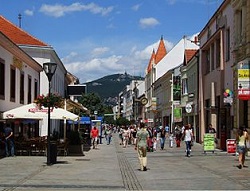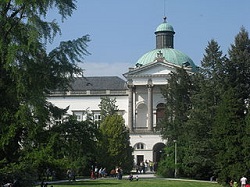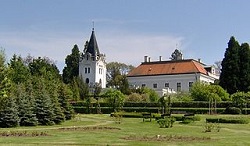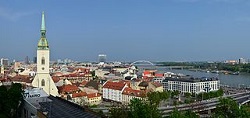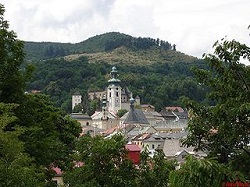SES 2014 SK
Partopreno
Praktikaj
Organizantoj
Sub aŭspicio de
Ni rekomendas
Ekskursoj
Ĉiuj ekskursoj estas aparte pagendaj – eblas mendi ilin ĝis 2014-06-30. Se vi aliĝos al ekskurso poste, ni ne plu povas garantii al vi liberan lokon.
Duontagaj ekskursoj
D: Urbo kaj kastelo Nitra (perpiede)
(prezo: 7 EUR, dato: 2014-07-13)
Nitra estas la plej malnova urbo de Slovakio, kiun kronikoj mencias jam en la 9-a jarcento. La unua skriba mencio devenis el 880, kiam Nitra estis episkopejo de Grandmoravia Regno. Nitra estas urbo de eksterordinara historia graveco. Komencoj de ĝia prisetlado estas en pratempo, kiel tion pruvas la arkeologiaj trovitaĵoj sur la urbo-tereno. Jam antaŭ 30 mil jaroj ĝi estis dense loĝigita areo. Areo de la nuna Nitra estis grava loko de Keltoj (jam kelkajn jarcentojn antaŭ Kristo), pli poste de Ĝermanoj kaj fine Slavoj. Ĝi estis sidejo de unuaj konataj regantoj de la nuntempa regiono de Slovakio – germanaj triboj "Kvadoj" (ĉ. j. 396 p.K.) kaj ekde la 8-a jarcento ĝis 1108 sidejo de la Nitra-princlando.
La plej fama historia memoraĵo kaj dominanto de la urbo estas kastelo el la 11-a jarcento, en la 15a jarcento rekonstruita kaj ankoraŭ ŝanĝata en la epoko de baroko. La kastelo estis konstruita sur la loko de la slava setlejo de la 9a jarcento. Ĝi estas nacia kultura heredaĵo. Hodiaŭ ĝi estas sidejo de la arkeologia departemento de SAV (Slovaka Akademio de Sciencoj) kaj de episkopo. Viziteblaj estas nur la katedralo kaj la dioceza muzeo.
Pli da informoj ĉe la oficiala retejo...
Pli da informoj en Vikipedio...
E: Topoľčianky
(prezo: 15 EUR, dato: 2014-07-15)
Topoľčianky estas ne tre granda civito, sed tamen kun multaj vidindaĵoj. Unua skrib-notita mencio pri la civito estas el la jaro 1293. Tamen jam en la 6-a kaj 7-a jarcento ĉi tie loĝis slavoj. La ekskurso havos buntan programon, ni provos viziti ĉion vidindan:
- Vin-produktejon (kun vingustumado): la vinproduktejo Topoľčianky produktas 5 milionojn da litroj de vino jare, kaj per tio ĝi estas unu el la plej grandaj vinfarantoj en Slovakio;
- Burgon el la 15-a jarcento: ekde la jaro 1890 la posedaĵon aĉetis Habsburga familio, kiu posedis ĝin ĝis la disfalo de la monarkio. Jozefo Aŭgusto Habsburga tre ekŝatis la lokon, riĉigis la ekipaĵon de la burgo, grandigis la parkon, fondis la ĉevalejon kaj ĉeval-bredejon kaj la ĉasistan kastelon. Post la disfalo de monarkio la kastelon aĉetis registaro de Ĉeĥoslovakio kaj ĝi iĝis somera sidejo de prezidentoj de ČSR. Regule ĉi tie estadis ĉefe prezidento Tomáš Garrigue Masaryk. La kastelo estas nacia kultura heredaĵo.
- Bizon-bredejon: bizon-bredejo estis fondita en 1958, kun la tasko helpi savi Eŭropan bizonon antaŭ la formorto, ĉar en la tempo de ĝia ekesto vivis tutmonde nur 150 pecoj de tiu ĉi specio. La bredejo havas areon de 140 hektaroj. La Eŭropa bizono estas la plej granda kaj peza kontinenta mamulo de Eŭropo. La Eŭropa bizono estas boveda mamulo, kiu vivas en Eŭropo, nuntempe plejparte nur en Pollando kaj Belorusio, pli ekzakte en la praarbaro de Białowieża.
Pli da informoj ĉe la oficiala retejo...
Pli da informoj en Vikipedio...
F: Arboreto Mlyňany
(prezo: 10 EUR, dato: 2014-07-18)
Arboreto Mlyňany de Slovakia Akademio de Sciencoj (arboreto – kolekto de arbospecioj) estas protektita areo ĉe la komunumoj Tesárske Mlyňany kaj Vieska nad Žitavou (distrikto Zlaté Moravce). Ĝi okupas 67 hektarojn. En la jaro 1951 ĝi estis deklarita kiel protektita areo. Nuntempe ĝi estas scienca laborloko de Slovakia Akademio de Sciencoj.
Fondinto D-ro Štefan Ambrózy-Migazzi el Hungario estis ekde sia infanaĝo granda ŝatanto de botaniko. Kun sia edzino el Zlaté Moravce, Antónia, li konstruigis kastelon apud Vieska nad Žitavou, rande de arbaro. Ĝuste en tiu ĉi arbaro li komencis provi planti unuajn alilandajn arbospeciojn.
Hodiaŭ estas la arboreto la plej signifa arbologia institucio en Slovakio. Ĝiaj kolektoj enhavas pli ol 2300 arbospeciojn el Mediteraneo, Ameriko, Afriko kaj Azio.
Pli da informoj ĉe la oficiala retejo...
Pli da informoj en Vikipedio...
Tuttagaj ekskursoj
Rimarko: Vi povas elekti maksimume unu el la tuttagaj ekskursoj, ĉar ambaŭ okazos dum la sama tago (merkrede, 2014-07-16).
A: Bratislava
(prezo: 27 EUR, dato: 2014-07-16)
Vizitotaj lokoj: burgruino Devín, Bratislava kastelo, malnova urboparto, galerio de moderna arto Danubiana, kaj io pli...
Bratislava estas ĉefurbo kaj la plej multe loĝigata urbo de Slovakio (pli ol 425 mil loĝantoj). En la urbo havas sidejon la ŝtatprezidanto, registaro, parlamento, diversaj oficejoj kaj ministerioj, ankaŭ pluraj universitatoj, teatroj, muzeoj kaj aliaj kulturaj kaj sciencaj institucioj. Bratislavo situas sur ambaŭ bordoj de rivero Danubo, sur montarpiedo de Malgrandaj Karpatoj. La urbo estas proksime de Ĉeĥio, Aŭstrio kajHungario. Ĝi estas la unusola ĉefurbo en la mondo, kiu limas samtempe kun du landoj (Hungario kaj Aŭstrio).
Historio. En la areo de la urbo estis trovitaj viv-spuroj eĉ de ŝtonepoko. Ĉirkaŭ 400 a.K. – 50 a. K. en la areo loĝis keltoj, kiuj konstruis tie sian fortikaĵon. Ekde la 1-a ĝis la 5-a jarcento tra la urbo kondukis limo de Roma Imperio. Ekde la 6-a jarcento sur la loko de la urbo ekloĝis la unuaj slavoj. En la jaro 907 aperis la unua skribmencio pri bratislava en salzburgaj analoj. Dum la jaroj 907 – 1918 Bratislavo estis parto de Hungara reĝlando kaj dum la jaroj 1536 – 1784 ĝi estis eĉ la ĉefurbo de Hungara reĝlando. La urbo estis parto de Ĉeĥoslovakio inter 1919 kaj 1992, krom dum la ĥaosa milita periodo de 1939-1945, kiam ĝi estis ĉefurbo de slovaka marioneta ŝtato sub nazia rego. Ekde la jaro 1993 Bratislavo estas ĉefurbo de memstara Slovakio.
Devín. Ekde 1946 urbo Devín estas parto de Bratislavo (8 km for de la centro de la urbo), kiu situas sur montetoj kaj deklivoj ĉe kunfluejo de riveroj Danubo kaj Moravo. La vilaĝo estis menciita unuafoje en la jaro 1237 en formo villa Thebyn. En la 13-a jarcento la hungara reĝa fortikaĵo estis konstruita en la loko kaj ricevis la nomon Dyven. En 1809 armeo de Napoleono detruis la fortikaĵon. Ľudovít Štúr tie komencis nacian movadon de la slovakoj en 1836.
Pli da informoj ĉe la oficiala retejo...
Pli da informoj en Vikipedio... (eo: = fonto, CC BY-SA)
B: Banská Štiavnica
(prezo: 27 EUR, dato: 2014-07-16)
Banská Štiavnica estas historia urbo en meza Slovakio, kun tre multkultura pasinteco. Ĝi estas konata per minado de metaloj (ĉefe de arĝento), per gravaj minejaj juro, administracio kaj akademia tradicio. Ni spertos malsupreniron en subteran minejon ĉe Subĉiela Minmuzeo, ĉiu ekipita per kasko, lampo kaj mantelo. Post tagmanĝo en pensiono ni trarigardos la Malnovan Kastelon, vizitos mineralogian ekspozicion kaj la vendejon Verkoj de slovakiaj belartistoj. Nian ekskurson ni finos en la teejo Divná pani. La urbo mem estas enskribita en la Unesko-listo de kulturaj heredaĵoj.






